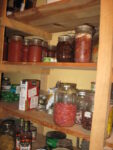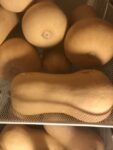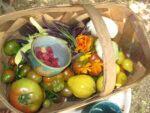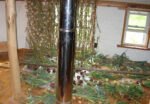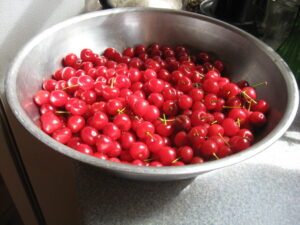A version of this column first ran in the Roane County (WV) Reporter and Times Record. Support local journalism! Subscribe to your local newspaper. This is one of a series of blogs for new gardeners. Read the rest: Part 1. Part 2. Part 3. Part 4. Part 5. Part 6. Part 7. Part 8. Part 9. Part 10.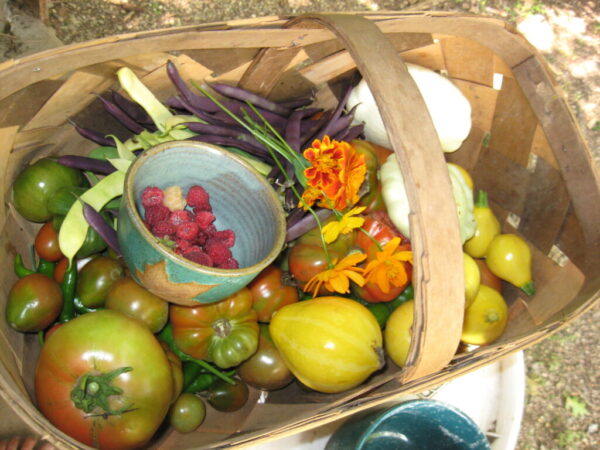
There are gardeners who do everything else right—choose their seed carefully, plant and weed and water and mulch…and then neglect to harvest the crops. You may be busy when your crops are ready for harvest, but this is the payoff, the point of the whole effort, so don’t neglect gathering your produce. Some crops lose quality very quickly if not harvested at the right time.
You should have been harvesting lettuce, spinach and radishes for some time now—in fact these crops may be bolting, sending up seed stalks and becoming bitter (the lettuce and spinach) or woody (the radishes). I know of no way to preserve lettuce or radishes but you can freeze spinach—after steaming it. Spinach condenses so much with cooking it wouldn’t make sense to take up extra room in your freezer with raw spinach.
Peas are winding now, too. I harvested sugar snaps and snow peas, and froze some. I have planted pole beans on the other side of the fence; as the peas will turn yellow and unproductive , and I pull them.
One thing that benefits from the shade of peas and then beans is ginger, something I first tried last year. It requires overwintering the rhizomes as potted plants in a window, but I was pleased with the results last fall, when I dug four-foot-tall plants and divided a lot of rhizomes, retaining one chunk to make the potted plant for this past winter. Ginger is very tender, and needs frequent watering and partial shade. Celery also benefits from shade in the hot months.
Broccoli LOS has been ready. I’d say there’s a four day window between the time the little green beads of a broccoli head achieve full size and the time they get bitter and turn into yellow flowers. Broccoli freezes very well. My bok choy have all bolted and been harvested now, while my cabbages are just starting to make heads. But surprisingly, I’ve yet to see any worms on these crops. This despite the fact that my butterfly weeds are full of butterflies (go figure!) so it’s not that the butterflies are gone.
Speaking of flowers, these can be on the harvest list too. Just because your prime motive in allowing them in your vegetable garden is to foster predator bugs and pollinators doesn’t mean you can’t snip a few and use them in bouquets.
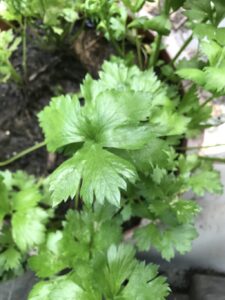 It’s early to pull celery but I have been doing so because they have a disease, which I suspect is aster yellows, spread by leaf hoppers. By now they all have it, but they’re still growing. I cut off the tops and hang them from nails in my kitchen rafters, and use the dried, crumbled leaves as flavoring. The stalks go in the vegetable bin of the refrigerator.
It’s early to pull celery but I have been doing so because they have a disease, which I suspect is aster yellows, spread by leaf hoppers. By now they all have it, but they’re still growing. I cut off the tops and hang them from nails in my kitchen rafters, and use the dried, crumbled leaves as flavoring. The stalks go in the vegetable bin of the refrigerator.
Soon the summer squash will be ready. Those are best harvested small—a few days OF neglect and you have baseball bats out there, and as with many plants, if you let them mature their seed they’ll stop producing. Summer squash can also be frozen for winter use.
Cucumbers should also be picked promptly, and can be pickled. The library has good books on pickling but I don’t know when we’ll be able to get our hands on them. However, you can find recipes for about anything if you have internet access.
Onions and garlic will be ready for harvest soon. The usual advice for onions is to wait until the leaves of half of them have fallen over, then knock over the rest and pull them a day later. You can then leave them in the garden for a day or two to cure if it’s dry; then find a non-sunny, dry place for them to cure over a couple of weeks. You can then clean them off, snip off the roots, and either cut off the tops and put them in onion bags, or braid the tops, which is what I do. I tie off the tops of the braids with string and hang them from those nails in my kitchen.
Garlic is treated much like onions but harvested about a week earlier. I have better luck with the hardneck type, which send up a seed scape—these are rather ornamental but must be clipped off so the plant sends its energies into the roots rather than into making little baby bulbs as seeds. The softneck type can be braided like onions. Yellowing of the tips is a sign they are getting ready; you can also harvest one at a time to assess their progress—have the cloves formed or is it still one lump? If you wait too long the cloves will start separating from each other. Garlic and onions keep best in dry conditions; garlic can tolerate below-freezing temps but onions will rot if exposed to a freeze.
Many vegetables are best preserved by canning or storage in a root cellar but those are not the ones coming ripe now—I’ll address those later.
